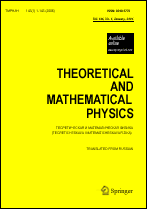|
This article is cited in 3 scientific papers (total in 3 papers)
Description of stable chemical elements by an $aF$ diagram and mean square fluctuations
V. P. Maslov
Moscow Institute of Electronics and Mathematics — National Research University "Higher School of Mathematics", Moscow, Russia
Abstract:
We study the process of a nucleon separating from an atomic nucleus from
the mathematical standpoint using experimental values of the binding energy
for the nucleus of the given substance. A nucleon becomes a boson at the instant of separating from a fermionic nucleus. We study the further
transformations of boson and fermion states of separation in a small
neighborhood of zero pressure and obtain new important parastatistical
relations between the temperature and the chemical potential when a nucleon
separates from an atomic nucleus. The obtained relations allow constructing
a new diagram (an $aF$ diagram) or isotherms of very high temperatures
corresponding to nuclear matter. We mathematically prove that the transition
of particles from the domain governed by Fermi–Dirac statistics to the domain governed by Bose–Einstein statistics near the zero pressure $P$
occurs in the neutron uncertainty domain or halo domain. We obtain equations
for the chemical potential that allow determining the width of the uncertainty domain. Based on the calculated values of the minimum
intensivity for Bose particles, the chemical potential, the compressibility
factor, and the minimum mean square fluctuation of the chemical potential,
we construct a table of stable nuclei of chemical elements, demonstrating a monotonic relation between the nucleus mass number and the other parameters.
Keywords:
energy of neutron separation from the atomic nucleus, nucleus binding energy, neutron domain of uncertainty, parastatistics (Gentile statistics), mean square fluctuations of energy and chemical potential, nuclear matter.
Received: 22.05.2019
Revised: 19.06.2019
Citation:
V. P. Maslov, “Description of stable chemical elements by an $aF$ diagram and mean square fluctuations”, TMF, 201:1 (2019), 65–83; Theoret. and Math. Phys., 201:1 (2019), 1468–1483
Linking options:
https://www.mathnet.ru/eng/tmf9754https://doi.org/10.4213/tmf9754 https://www.mathnet.ru/eng/tmf/v201/i1/p65
|


|




 Contact us:
Contact us: Terms of Use
Terms of Use
 Registration to the website
Registration to the website Logotypes
Logotypes








 Citation in format
Citation in format 
